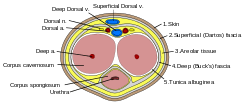Tunica albuginea (penis)
| Tunica albuginea (penis) | |
|---|---|
 Transverse section of the penis. | |
 The penis in transverse section with tunica albuginea shown. | |
| Details | |
| Latin | tunica albuginea corporum cavernosorum, tunica albuginea corporis spongiosi |
| Identifiers | |
| Gray's | p.1250 |
| Dorlands /Elsevier | t_22/12831755 |
| TA |
A09.4.01.017 A09.4.01.018 |
| FMA | 19630 |
| Anatomical terminology | |
The tunica albuginea is the fibrous envelope of the corpora cavernosa penis. It consists of approximately 5% elastin, an extensible tissue that is primarily made up of the amino acids glycine, valine, alanine, and proline. The majority of the remaining tissue is collagen, which is made up of lysine, proline, glycine, alanine, and other amino acids.[1]
The tunica albuginea is directly involved in maintaining an erection; that is due to Buck's fascia constricting the deep dorsal vein of the penis, preventing blood from leaving and thus sustaining the erect state.
The trabeculæ of the tunica albuginea are more delicate, nearly uniform in size, and the meshes between them smaller than in the corpora cavernosa penis: their long diameters, for the most part, corresponding with that of the penis.
The external envelope or outer coat of the corpus spongiosum is formed partly of unstriped muscular fibers, and a layer of the same tissue immediately surrounds the canal of the urethra.
Additional images
-

The penis in transverse section, showing the blood vessels.
References
This article incorporates text in the public domain from the 20th edition of Gray's Anatomy (1918)
External links
- Anatomy photo:42:07-0103 at the SUNY Downstate Medical Center - "The Male Perineum and the Penis: The Corpus Spongiosum and Corpora Cavernosa"
- Image at downstate.edu
- Image at downstate.edu
- Histology image: 17703loa — Histology Learning System at Boston University
| ||||||||||||||||||||||||||||||||||||||||||||||||||||||